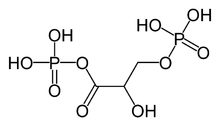1,3-BPG
 |
|
 |
|
| Names | |
|---|---|
|
IUPAC name
(2-Hydroxy-3-phosphonooxy-propanoyloxy)phosphonic acid
|
|
| Other names
1,3-Diphosphoglycerate; Glycerate-1,3-bisphosphate; Glycerate-1,3-biphosphate; 1,3-Biphosphoglycerate; 3-Phosphoglyceroyl phosphate; Glyceric acid-1,3-diphosphate
|
|
| Identifiers | |
|
3D model (JSmol)
|
|
| Abbreviations | 1,3BPG; 1,3-BPG; PGAP |
| ChemSpider | |
|
PubChem CID
|
|
|
|
|
|
| Properties | |
| C3H8O10P2 | |
| Molar mass | 266.03 g·mol−1 |
|
Except where otherwise noted, data are given for materials in their standard state (at 25 °C [77 °F], 100 kPa).
|
|
|
|
|
| Infobox references | |
1,3-Bisphosphoglyceric acid (1,3-Bisphosphoglycerate or 1,3BPG) is a 3-carbon organic molecule present in most, if not all, living organisms. It primarily exists as a metabolic intermediate in both glycolysis during respiration and the Calvin cycle during photosynthesis. 1,3BPG is a transitional stage between glycerate 3-phosphate and glyceraldehyde 3-phosphate during the fixation/reduction of CO2. 1,3BPG is also a precursor to 2,3-bisphosphoglycerate which in turn is a reaction intermediate in the glycolytic pathway.
1,3-Bisphosphoglycerate is the conjugate base of 1,3-bisphosphoglyceric acid. It is phosphorylated at the number 1 and 3 carbons. The result of this phosphorylation gives 1,3BPG important biological properties such as the ability to phosphorylate ADP to form the energy storage molecule ATP.
Compound C00118 at KEGG Pathway Database. Enzyme 1.2.1.12 at KEGG Pathway Database. Compound C00236 at KEGG Pathway Database. Enzyme 2.7.2.3 at KEGG Pathway Database. Compound C00197 at KEGG Pathway Database.
As previously mentioned 1,3BPG is a metabolic intermediate in the glycolytic pathway. It is created by the exergonic oxidation of the aldehyde in G3P. The result of this oxidation is the conversion of the aldehyde group into a carboxylic acid group which drives the formation of an acyl phosphate bond. This is incidentally the only step in the glycolytic pathway in which NAD+ is converted into NADH. The formation reaction of 1,3BPG requires the presence of an enzyme called glyceraldehyde-3-phosphate dehydrogenase.
...
Wikipedia
